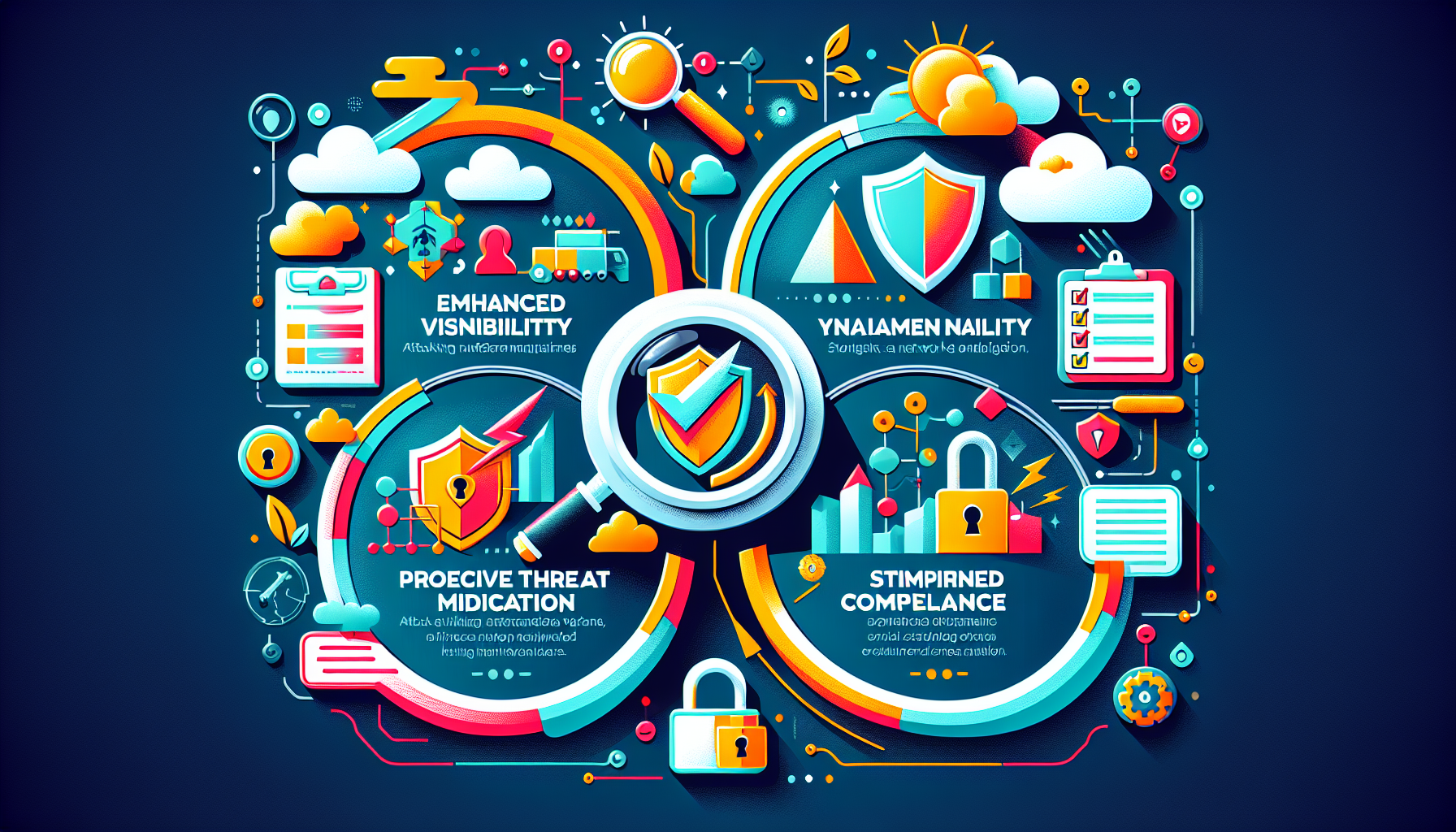Selecting the right attack surface management vendor is essential for safeguarding sensitive data and securing your organization against vulnerabilities. Attack surface management involves identifying and mitigating risks across your digital footprint. In this guide, we will explore the top attack surface management vendors of 2024, their key features, and benefits to help you make informed decisions.
Key Takeaways
-
Top vendors such as FireCompass, UpGuard, Palo Alto Networks, and Mandiant offer comprehensive solutions for effective attack surface management, each with unique features tailored to enhance cybersecurity.
-
Key features to consider in ASM solutions include comprehensive asset discovery, continuous security monitoring, and risk prioritization, all of which are crucial for identifying and mitigating vulnerabilities.
-
Emerging trends in ASM emphasize the integration of AI and machine learning, the alignment with DevSecOps, and the need for robust security measures for IoT and cloud environments in response to evolving cyber threats.
Top Attack Surface Management Vendors
Choosing the appropriate ASM vendor safeguards your organization’s sensitive data and minimizes breach exposure.
Here are some of the top vendors in the market today that excel in providing comprehensive attack surface management solutions.
FireCompass
FireCompass stands out with its Next Gen EASM, which combines passive and active reconnaissance with pen testing playbooks. Their AI-based learning significantly reduces false positives and actively validates discovered risks, helping organizations focus on genuine threats and reduce alert fatigue.
With continuous risk-hunting playbooks, FireCompass identifies critical risks within 24 hours, providing real-time alerts and proactive threat detection.
>>Outspeed Attackers with AI-Powered Penetration Testing & ASM
UpGuard
UpGuard is designed to benefit companies of all sizes. It offers continuous attack surface monitoring, helping organizations stay updated on their digital risks and enhance their security posture. UpGuard’s features help security teams manage risks and enhance their overall cybersecurity strategy.
Palo Alto Networks
Palo Alto Networks provides extensive visibility into internet-facing assets, enhancing security management. Known for its robust capabilities in attack surface management, it offers organizations the tools necessary to secure their internal and corporate networks. This ensures a strong cybersecurity posture and comprehensive protection against potential threats.
Mandiant Advantage
Mandiant focuses on comprehensive external attack surface management, identifying and mitigating risks in real-time. With continuous monitoring, Mandiant quickly identifies new vulnerabilities and threats. Their expert threat analysis combines threat intelligence with manual review, significantly enhancing the overall security posture of organizations.
Key Features to Look for in ASM Solutions
When considering an ASM solution, it’s essential to look for specific features that ensure comprehensive protection. Key functionalities include asset discovery and vulnerability scanning tailored to your business needs, continuous monitoring, and risk prioritization.
These features help organizations identify and address potential vulnerabilities before they can be exploited.
Comprehensive Asset Discovery
The initial stage of an ASM solution involves the discovery of internet-facing digital assets, which is crucial for understanding an organization’s exposure to threats. Known assets include devices, systems, and applications authorized to connect to the network, while unknown assets may include rogue devices and unauthorized systems.
ASM tools provide in-depth visibility into an organization’s IT environment, automating the discovery of external assets to help maintain an updated inventory of network exposure.
Continuous Security Monitoring
Ongoing monitoring ensures continuous scrutiny of vulnerabilities and changes in the IT environment. ASM solutions provide real-time alerts for immediate response to identified threats, which is essential for timely remediation efforts.
Including ASM in DevSecOps pipelines enhances software development security by addressing vulnerabilities early.
Risk Prioritization and Scoring
ASM tools should facilitate risk scoring by evaluating the likelihood of exploitation and potential impact on the organization, especially in the context of threat actors. Organizations need to evaluate the likelihood of exploitation, potential attack impact, and remediation difficulty when prioritizing vulnerabilities.
Tailoring observations and recommendations from assessments to focus on high-impact issues enhances an organization’s ability to manage risks effectively.
>>Click Here To Checkout The Questions To Ask While Selecting An External Attack Surface Management (EASM) Vendor
Benefits of Using Attack Surface Management Vendors
Engaging with ASM vendors offers several benefits, including increased visibility into an organization’s attack surface, proactive threat mitigation, and streamlined compliance efforts. These benefits help organizations enhance their cybersecurity posture and manage risks more effectively.
Enhanced Visibility
UpGuard assists organizations in preventing data breaches. It also monitors third-party vendors, which significantly enhances their overall security posture. Attack surface scoring is an important method utilized to evaluate an organization’s security posture in relation to exposed assets. Enhanced visibility is crucial for effectively managing attack surfaces and providing detailed insights into exposed assets.
Proactive Threat Mitigation
Automated attack surface management software helps security teams monitor and manage vulnerabilities as they appear. Proactive threat mitigation focuses on identifying and mitigating potential vulnerabilities before they can be exploited. This method allows security teams to swiftly address issues and prevent the escalation of cyber risks.
Streamlined Compliance
ASM ensures organizations meet regulatory standards by identifying security gaps and complying with regulations like GDPR and HIPAA. ASM solutions’ continuous monitoring helps organizations adhere to regulatory standards and avoid penalties.
This helps protect sensitive data and maintain compliance with industry regulations.
Challenges Addressed by ASM Vendors
ASM vendors address several challenges in managing an organization’s attack surface, including identifying unknown assets, keeping up with evolving threats, and integrating with existing security tools. These challenges are critical to maintaining a robust cybersecurity posture.
Managing Unknown Assets
Organizations often struggle to track and manage their assets due to rapidly changing infrastructure that can quickly introduce new vulnerabilities. Malicious or rogue assets deployed by cybercriminals pose significant threats today.
ASM vendors help discover and manage these unknown assets, reducing exposure to risks.
Keeping Up with Evolving Threats
The nature of cyber threats is dynamic, requiring organizations to continuously adapt their defenses. Attackers can scan for vulnerable systems in less than an hour, emphasizing the need for up-to-date defenses.
Effective ASM provides contextual information to prioritize fixes and address the most significant risks and impacts.
Integrating with Existing Security Tools
Seamless integration with existing security operations is crucial for maintaining a cohesive defense strategy against potential threats. Integration ensures all security tools work together efficiently, helping organizations respond to threats effectively.
How to Choose the Right ASM Vendor
Selecting the right ASM vendor requires understanding your organization’s specific security requirements and how vendors can meet them. This involves assessing security needs, evaluating vendor capabilities, and considering budget and ROI.
Assessing Your Security Needs
After identifying all assets, the next step in attack surface management is to ensure visibility and comprehend their security implications. It’s essential to map these identified assets to specific business units and integrate them with SOC tools for better monitoring and management.
Regularly assessing and addressing security gaps helps maintain robust defenses.
Evaluating Vendor Capabilities
Look for ASM vendors with proven reputations and recognition from reputable third-party analysts. Assessing vendor capabilities ensures they match your organizational goals and security needs.
Considering Budget and ROI
Balancing ASM solution costs with your budget while ensuring positive returns on your cybersecurity investment is crucial. Assessing the financial investment against the potential return in enhanced security and risk mitigation is key to making an informed decision.
>>Click here To See The Key Capability Matrix for Evaluating External Attack Surface Management EASM Vendors
Emerging Trends in Attack Surface Management
The growing emphasis on ASM is driven by the need for organizations to defend against increasingly sophisticated cyber threats. Emerging trends in ASM include AI and machine learning, integration with DevSecOps, and the expansion of IoT and cloud security.
AI and Machine Learning
Advanced threat detection capabilities will improve as AI and machine learning analyze large datasets to identify potential security threats more accurately. Integrating AI and machine learning into ASM tools enhances threat detection and optimizes incident response times.
Integration with DevSecOps
Combining ASM with DevSecOps strengthens security protocols within development pipelines. ASM tools can automatically detect new applications or services, ensuring timely vulnerability assessments.
This integration allows for immediate feedback on security postures following changes in code or infrastructure.
Expansion of IoT and Cloud Security
The incorporation of specialized IoT assessment capabilities is essential for managing the unique security challenges posed by IoT devices. Securing IoT devices and cloud services infrastructures is becoming critical as these areas expand, introducing new vulnerabilities.
Future ASM solutions must focus on managing security across multi-cloud environments to tackle complex attack surface challenges.
Summary
In summary, attack surface management is essential for protecting organizations against evolving cyber threats. Selecting the right ASM vendor involves understanding your security needs, evaluating vendor capabilities, and considering budget and ROI. Key features like comprehensive asset discovery, continuous monitoring, and risk prioritization are crucial for effective ASM. By leveraging these features, organizations can enhance their visibility, mitigate threats proactively, and streamline compliance efforts.
Staying ahead of emerging trends like AI and machine learning, integration with DevSecOps, and the expansion of IoT and cloud security will ensure your organization remains resilient against future threats. Take proactive steps in managing your attack surface to safeguard your digital assets and maintain a robust security posture.
Frequently Asked Questions
What is Attack Surface Management (ASM)?
Attack Surface Management (ASM) is essential for organizations as it focuses on identifying, monitoring, and managing digital assets to minimize vulnerabilities and enhance protection against cyber threats. By providing a comprehensive view of the attack surface, ASM aids in prioritizing remediation efforts and significantly reduces the risk of cyberattacks.
Why is continuous monitoring important in ASM?
Continuous monitoring is vital in Adaptive Security Management (ASM) as it facilitates real-time detection of vulnerabilities and threats, enabling organizations to promptly respond and maintain a strong security posture. This ongoing vigilance is essential for adapting to the ever-evolving IT landscape.
How do ASM solutions help with regulatory compliance?
ASM solutions aid organizations in achieving regulatory compliance by identifying security gaps, continuously monitoring assets, and generating essential reports, thereby ensuring adherence to standards such as GDPR and HIPAA while safeguarding sensitive data and mitigating penalties.
What are the key features to look for in an ASM solution?
A comprehensive ASM solution should prioritize features such as asset discovery, continuous security monitoring, and risk assessment capabilities. These elements are essential for effectively identifying and mitigating potential vulnerabilities in a timely manner.
How do AI and machine learning enhance ASM solutions?
AI and machine learning significantly enhance ASM solutions by improving threat detection accuracy through the analysis of large datasets and optimizing incident response times, thereby increasing the overall effectiveness of security measures.




Comments